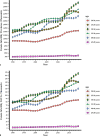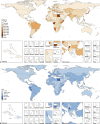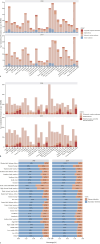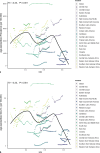Global, Regional, and National Prevalence and Disability-Adjusted Life-Years for Female Infertility: Results from a Global Burden of Disease Study, 1990-2019
- PMID: 39571567
- PMCID: PMC12324765
- DOI: 10.1159/000542408
Global, Regional, and National Prevalence and Disability-Adjusted Life-Years for Female Infertility: Results from a Global Burden of Disease Study, 1990-2019
Abstract
Objectives: We aimed to determine the prevalence of female infertility in 204 countries and territories from 1990 to 2019.
Design: We evaluated the female infertility global burden between 1990 and 2019 in this systematic study.
Materials: The Global Health Data Exchange query tool (http://ghdx.healthdata.org/gbd-results-tool) and sociodemographic index (SDI) (http://ghdx.healthdata.org/data-type/estimate) provided data on the annual prevalence numbers, age-standardized prevalence rates (ASR), and disability-adjusted life-years (DALYs) of female infertility in 204 countries and territories from 1990 to 2019 for various age groups.
Setting: Female infertility has a devastating impact on the physical and mental health of individuals and national fertility. However, most of the previous studies on this subject were conducted on rather small sample sizes and have certain limitations.
Methods: We examined female infertility in terms of prevalence, ASR, and DALYs across different age groups in 204 countries and territories from 1990 to 2019 using data from the Global Health Data Exchange query tool.
Results: From 1990 to 2019, ASR and DALYs for female infertility increased globally. At the SDI quintile level, middle-SDI and high-middle-SDI countries exhibited a faster increase in the ASR of female infertility. In 2019, with the highest female infertility rate recorded among those between the ages of 30-34 years and the lowest among those between the ages of 45-49 years. In 2019, high-income North America recorded the highest proportion of primary infertility, while East Asia recorded the lowest proportion.
Limitations: First, the global burden of disease (GBD) database lacks data for some countries and regions. Second, data access and quality differ across locations. Third, the causes of infertility are not comprehensive, and data on Klinefelter in GBD 2019 in relation to primary infertility were absent.
Conclusion: Globally, the prevalence of DALYs and age-standardized female infertility rates increased from 1990 to 2019.
Keywords: Disability-adjusted life-years; Female infertility; Global burden of disease study; Prevalence; Sociodemographic index.
© 2024 The Author(s). Published by S. Karger AG, Basel.
Conflict of interest statement
The authors declare that the research was conducted in the absence of any commercial or financial relationships that could be construed as a potential conflict of interest.
Figures






References
-
- Patra SA-O, Unisa S. Addressing reproductive health knowledge, infertility and coping strategies among rural women in India. J Biosoc Sci. 2021;53(4):557–65. - PubMed
-
- Ethics Committee of the American Society for Reproductive Medicine Electronic address asrm@asrmorg . Disparities in access to effective treatment for infertility in the United States: an Ethics Committee opinion. Fertil Steril. 2021;116(1):54–63. - PubMed
-
- Vander Borght M, Wyns C. Fertility and infertility: definition and epidemiology. Clin Biochem. 2018;62:2–10. - PubMed
-
- Zegers-Hochschild F, Adamson GD, Dyer S, Racowsky C, de Mouzon J, Sokol R, et al. The international glossary on infertility and fertility care, 2017. Fertil Steril. 2017;108(3):393–406. - PubMed
MeSH terms
LinkOut - more resources
Full Text Sources
Medical

